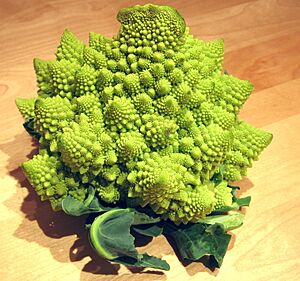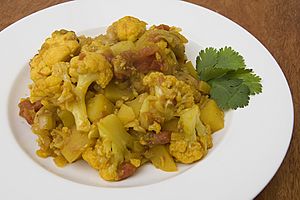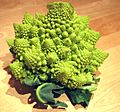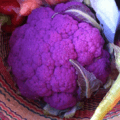Cauliflower facts for kids
Quick facts for kids Cauliflower |
|
|---|---|
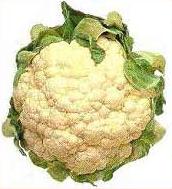
Cauliflower, cultivar unknown
|
|
| Species | Brassica oleracea |
| Cultivar group | Botrytis cultivar group |
| Origin | Northeast Mediterranean |
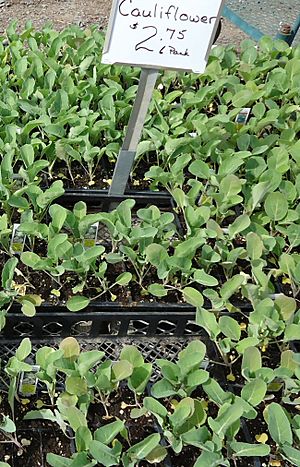
| Nutritional value per 100 g (3.5 oz) | |
|---|---|
| Energy | 104 kJ (25 kcal) |
|
5 g
|
|
| Sugars | 1.9 g |
| Dietary fiber | 2 g |
|
0.3 g
|
|
|
Protein
|
1.9 g
|
| Vitamins | Quantity
%DV†
|
| Thiamine (B1) |
4%
0.05 mg |
| Riboflavin (B2) |
5%
0.06 mg |
| Niacin (B3) |
3%
0.507 mg |
| Pantothenic acid (B5) |
13%
0.667 mg |
| Vitamin B6 |
14%
0.184 mg |
| Folate (B9) |
14%
57 μg |
| Vitamin C |
58%
48.2 mg |
| Vitamin E |
1%
0.08 mg |
| Vitamin K |
15%
15.5 μg |
| Minerals | Quantity
%DV†
|
| Calcium |
2%
22 mg |
| Iron |
3%
0.42 mg |
| Magnesium |
4%
15 mg |
| Manganese |
7%
0.155 mg |
| Phosphorus |
6%
44 mg |
| Potassium |
10%
299 mg |
| Sodium |
2%
30 mg |
| Zinc |
3%
0.27 mg |
| Other constituents | Quantity |
| Water | 92 g |
|
Link to USDA Database entry
|
|
| †Percentages estimated using US recommendations for adults. | |
Cauliflower is a popular vegetable that belongs to the same plant family as broccoli and cabbage. We usually eat its white, rounded part, which is called the "head" or "curd." This head is actually made of many tiny flower parts.
Cauliflower grows from a seed each year. Its name comes from Latin words that mean "cabbage flower." Other vegetables in the same plant family include brussels sprouts, collard greens, and kale. Even though they are related, they look and taste different!
Cauliflower has been around for a very long time. It was brought to France from Italy in the 1500s. It became more common on dinner tables during the time of King Louis XIV.
Contents
Different Kinds of Cauliflower
There are many different types of cauliflower grown around the world. Farmers and gardeners use hundreds of different varieties.
Cauliflower Colors
Most people think of cauliflower as white. However, it can also come in other colors!
- Orange cauliflower gets its color from extra vitamin A.
- Purple cauliflower gets its color from special plant chemicals called anthocyanins. These are the same chemicals that make red cabbage purple.
- Green cauliflower is sometimes called "broccoflower." It's a mix between broccoli and cauliflower.
-
Green Romanesco cauliflower has a unique spiral shape.
One special type is called Romanesco cauliflower. It's green and has a very cool, spiky, spiral shape.
Eating and Nutrition
Cauliflower is a very healthy vegetable! It's low in fat and carbohydrates. It's also packed with good things like dietary fiber, folate, and lots of vitamin C. This means it has a high nutritional density, giving you many nutrients for few calories.
Cauliflower also contains special plant compounds that are good for your health. These compounds are common in the cabbage family.
Cooking Cauliflower
You can cook cauliflower in many ways:
- You can roast it in the oven.
- You can boil it in water.
- You can steam it.
- You can fry it.
- You can even eat it raw in salads!
When you cook cauliflower, you usually remove the outer leaves and thick stalks. You only use the florets, which are the small, tree-like parts of the head. The leaves are also edible, but they are often thrown away. It's best to break the florets into similar sizes so they cook evenly.
Cauliflower can be a great substitute for potatoes or rice in some dishes, especially for people who want to eat fewer carbohydrates. It can give a similar texture, even though it doesn't have the same starch.
History of Cauliflower
People have known about cauliflower for a very long time. The oldest records of it go back to the 6th century B.C. The Roman writer Pliny wrote about it in the 2nd century.
In the 1100s, three types of cauliflower were described in Spain. They were brought there from Syria, where it had probably been grown for over a thousand years. Arab botanists also wrote about it in the 12th and 13th centuries, saying it came from Cyprus.
Images for kids
-
Orange and purple hybrids of cauliflower
-
Cauliflower as a velouté sauce
-
Green Romanesco cauliflower
See also
 In Spanish: Coliflor para niños
In Spanish: Coliflor para niños


